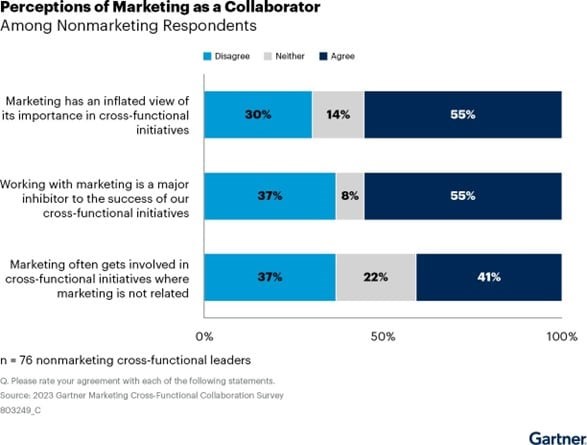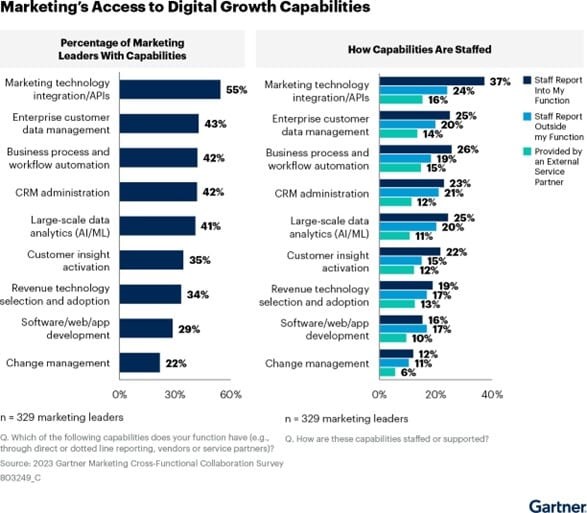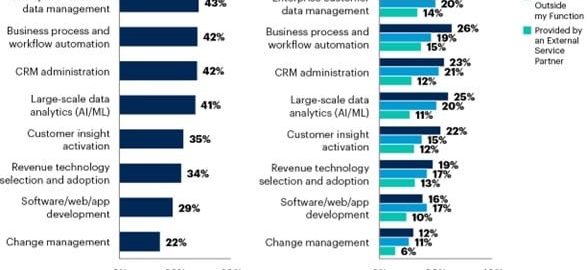Marketing is getting more involved with cross-functional teams — and a lot of non-marketers don’t see this as a value add.
The enterprise-wide adoption of AI is adding to marketers’ responsibilities but diminishing their control over key technologies. That’s the conclusion of new Gartner reports about what CMOs need to focus on in the coming year.
AI technologies are prompting organizations to pursue more digital growth initiatives which are being handled by cross-functional teams. Marketing leaders spend 17% more time collaborating cross-functionally than their non-marketing peers do, according to Gartner.
However, those non-marketers wish marketing was spending less time doing this, as 55% said “marketing has an inflated view of its importance” to these efforts. The same percentage said having to work with marketing “is a major inhibitor” to the success of cross-functional initiatives.
One of the problems is that nearly everyone (81% of non-IT executive leaders) believes digital leadership is part of their job. This is understandable as digital growth initiatives are large, complex operations. Typically they have five to eight unique business functions involved and 20 to 35 people on the core project team.

“Companies’ pursuit of digital initiatives designed to harness disruptive new technologies and unlock growth have made marketing ‘ground zero’ for cross-functional collaboration,” Ewan McIntyre, chief of research and VP analyst in the Gartner Marketing practice, said in a statement. “With a wave of major disruptions apparent in the year ahead, CMOs must have a sense of urgency to ride this wave by utilizing emerging technologies and helping to orchestrate profitable growth across functions, or risk being swamped by it.”
Digital ownership shifts have diminished marketing’s influence. The marketing function risks having its operations diluted to the point “it can no longer drive long-term business health,” the report found.

“When I want to use certain channels, I have to go ask a favor and get on the schedule instead of having it be part of my deployment strategy,” said one CMO in the report.
How to win back peers and control? Gartner suggests benchmarking your current state of organizational in?uence “to prioritize cultivating the skills and relationships that marketing needs to be successful.” Specifically:
- Gauge how you are perceived in the organization, and engage peer leaders to gain actionable feedback about your level of in?uence and perceived value.
- Scope and pare back marketing’s involvement in cross-functional collaboration based on the potential bene?ts and distinctiveness of marketing contributions.
- Track and cultivate trusting relationships with key C-suite collaborators, especially the CIO.
- Mature your marketing team’s strategic and critical thinking skills so the team can add more value to complex initiatives.
- Coach and enable marketing team members to form more effective peer-level partnerships.
In the coming year, there are three things CMOs must focus on according to Gartner. First, build AI-enabled marketing teams, which may mean bringing in new expertise. Next, prove marketing’s value by focusing on its ability to drive business alignment through catalytic programs and leadership. Finally, do yourself and your people a favor — and give them time for more immediate needs — by not getting involved in every cross-functional effort. Limit it to the ones that will have the most impact and where marketing can truly bring something useful to the table.
Why we care. Sidelining or reducing marketing’s role is such an incredibly bad idea. It’s like saying, “We don’t really need customers.” That said, it is essential that marketing market itself within the organization. Prove your value and your usefulness. Be the helpful resource, not the people who know best. The people in the rest of the organization don’t understand that everything is marketing and they likely never will. Marketing needs to influence when it can’t directly lead.
The post AI is adding to marketers’ responsibilities while diminishing their influence appeared first on MarTech.
(10)
Report Post







